
Aurora at 187 Great Junction Street is not in the fashionable part of Leith but on a busy main road lined with small shops and eateries of all kinds. It does not have a waterfront view. It is certainly not the place where you would expect to come across a fine dining restaurant. Its frontage is easily missable and a peek through the window would reveal a narrow, high ceilinged room with minimal decoration and lighting.
And yet Aurora is making waves in the crowded Edinburgh restaurant scene, serving a seven-course tasting menu that could compete with its more established rivals. It has attracted both regular locals and those making a special trip.
This 18-cover restaurant has stripped pine floors and undressed pine tables lit by bulkhead lighting. Wine racks on high shelving are illuminated by spotlights. A few abstract prints decorate the blue walls and succulent plants line the front window sill. Clearly, with the unremarkable décor, furniture and fittings, the focus is all on the food. And what food it is! But first some background on the chef-patron…
Now aged 33, Kamil Witek’s culinary background is far from typical of most chefs. Indeed, he became a chef by accident. In Poland, he entered university with the ultimate aim of becoming an actor. Having realised this may not be the most stable and lucrative profession he turned to the chef world.

As a youngster, Kamil visited Edinburgh and was originally impressed by its lively and colourful culture, especially during the festival, when the city reminded him of his home in Krakow. He moved permanently to Edinburgh seven years ago, first as senior sous chef at The Apartment, then as sous and head chef at Salt Café in Morningside. There he acquired new skills and was given complete freedom to develop the menu, making a name for himself as a promising high-end chef. He eventually decided to open Aurora as a small all-day dining café four years ago. While this concept only took off at weekends, the monthly evening tasting menu proved very popular, so the menu slowly switched to tasting only. During lockdowns, popular takeaways and weekend-ready meals paid the bills, outside of that the new tasting concept was operating six months prior to the first lockdown, six months between lockdowns, and during the last three months. Business has been good, so while success is always a relative measure, so far so good.
By his own admission, it is difficult to describe his style of cooking. It is certainly “modern and global”, taking inspiration from different art and cultures, so through his tasting menu he likes to take his guests on a “global journey.” Kamil treats his team of six, three in the kitchen and three front of house, as a family, having worked with some of them in Krakow and at Salt.

The tasting menu changes four times a year with the seasons. Aurora has been lucky in retaining many of its original customers who have remained loyal through its various changes. As the tasting menu has choices in five of its courses, customers can return to enjoy the same menu but choosing different items. Foodies are coming from greater distances but the core of his clientele remains those who came for breakfast four years ago.
When asked to name a signature dish, Kamil considers campfire potatoes, charred on the outside and soft inside, which proved popular for seven years at Salt and Aurora. His smoked butter uses the same idea of the scout campfire aroma.
When considering the sampled food offering, it is bold in conception and accomplished in execution, displaying precision in cooking, employing a variety of techniques both classic and contemporary. Meat and fish cookery is accurately timed, enabling their true flavours to shine. Saucing is a particular strength, judiciously applied to highlight the main ingredient. Influences are international but combinations of ingredients are always harmonious, with balance in tastes, textures and temperatures. Equal care is given to vegetarian options, with a variety of popular and less well-known produce being used. Attention to detail is meticulous. The plating is clean, the presentation is beautiful and portions are generous.
Pricing of the seven-course menu at £52, which includes an amuse bouche and petit fours, is a steal for cooking of this skill using top-notch ingredients. The ubiquitous listing of ingredients for each dish, with no indication of cooking methods, is also evident here.
The wine list is mainly Old World with ungreedy markups. A flight of matching wines is £48, More interesting is the non-alcoholic matching selection priced at £30 created by manager /sommelier Cezar. The use of herbal essences, botanicals, non-alcoholic bitters, kombucha, vermouth, homemade lemongrass lemonade, calamansi, and lapsang souchong tea all featured in the flight we chose.
Fine Dining Guide visited Aurora on a weekday evening in September and was overwhelmed by the brilliance of the seven-course summer tasting menu.

A stunning amuse bouche featured a deep-fried potato flour parcel encasing fried egg yolk and topped with truffle shavings. This heavenly combination of crisp pastry, warm liquid centre and the heady fragrance of the luxurious fungus, to be consumed in one mouthful to avoid a mess, proved an original, opener.
A warm sourdough loaf was partnered with potato skin butter smoked under a cloche.
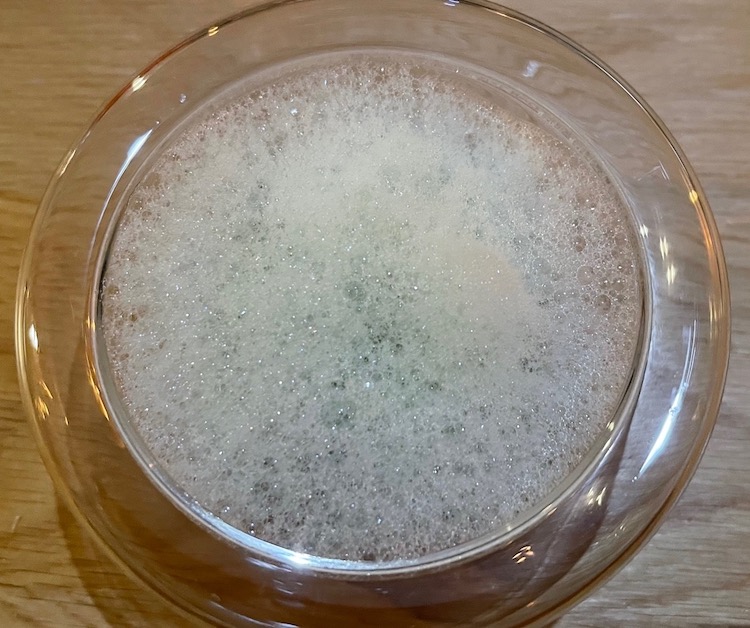
For the second course, a well-seasoned, sweet tomatillo gazpacho and refreshing cucumber sorbet with smoked almonds was enveloped by a cloud of cucumber foam which needed more umph to elevate the dish. It proved to be a minor flaw in the whole menu.
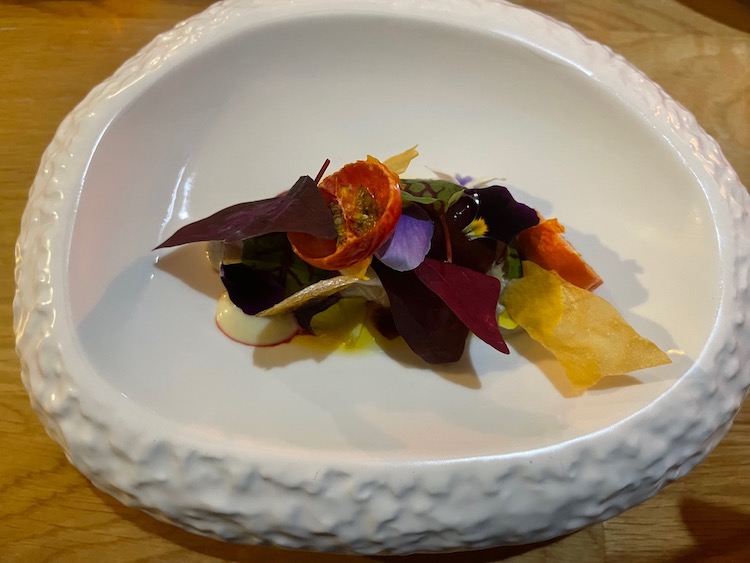
On the second course, a “Butterfly Salad” included radicchio and Chinese leaves, blanched to reduce their bitterness; cherry tomatoes, toasted pine nuts and cannellini beans; and six plant-based sauces including red wine balsamic, herb olive oil and beetroot jus. This colourful plate had soft and crisp textures with well-balanced dressings.
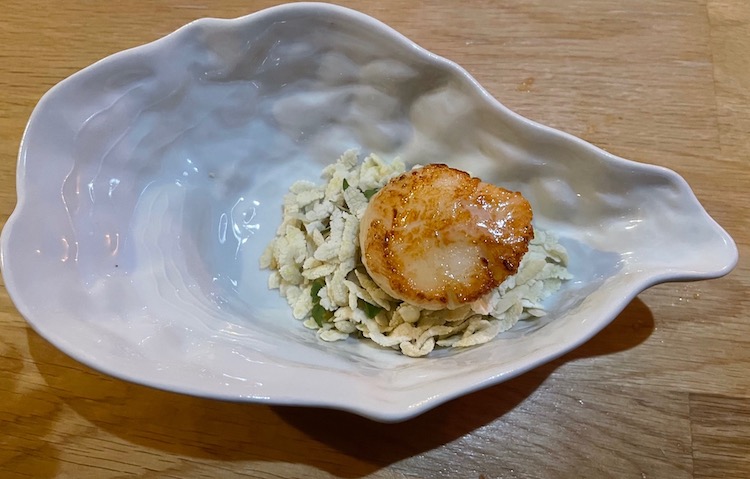
As an alternative on the second course, a plump scallop was seared to produce a caramelised crust and soft, sweet flesh. Toasted rice flakes gave a contrasting texture while passion fruit puree, wasabi aioli and dried shrimp paste added sharpness, a gentle heat and an umami note.

The third course featured an accurately timed pan-fried fillet of cod, resulting in delicate, moist and translucent white flakes of fish. It was served with a herbaceous plankton sauce, pickled daikon for contrasting texture and lemon oil and yuzu pearls for acidity. This dish fully demonstrated the versatility of the chef using classic and molecular cookery.
The fourth course comprised alternative pasta dishes.
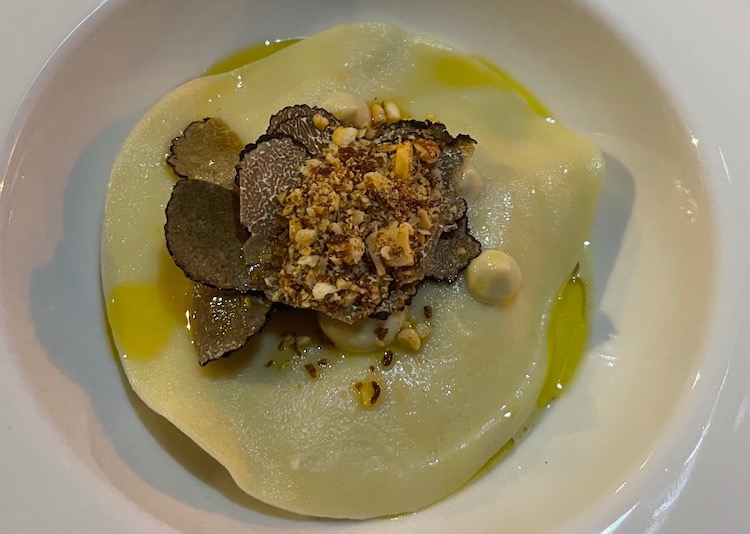
The wild mushroom open raviolo was a cornucopia of fragrant fungi. Layered above the silky pasta were artichoke cream, sauteed morels, chanterelles and shavings of summer black truffles. A sprinkling of toasted hazelnuts finished this earthy, aromatic dish of contrasting tastes and textures.

Zlikrofi, a Slovenian raviolo, was different in tone and shape and thicker than Italian pasta. Stuffed with potato and guanciale pork, and topped with Italian Montasio cheese, parsley sauce, fermented garlic powder, and powdered grisinii sticks, this was a more robust, hearty alternative to the open ravioli.
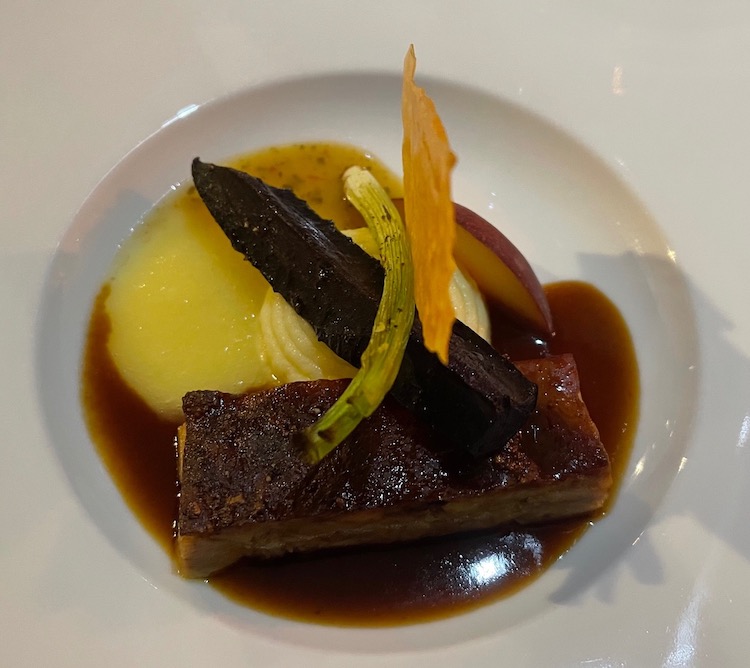
For the fifth course, we both chose the suckling pig. It had been cooked sous vide for 24 hours, pulled and crisped up. This tender, flavoursome porcine treat simply melted in the mouth. It worked well with the three accompanying sauces: a rich chicken jus, a sweet pineapple puree and punchy tiger milk of fish paste, chilli and lime. Potato glass chips, charred spring onions, and purple heritage carrot added crisp texture and a gentle smokiness to this original and accomplished dish.
A pre-dessert of beer foam and a tangy lemon gel satisfyingly refreshed the palate
Desserts showed the same degree of invention and flair as the preceding dishes.

A pear poached in rhubarb and elderflower Edinburgh gin had a soft, yielding texture and pronounced flavour. It was partnered with a velvety smooth quenelle of fennel and ginger ice cream and was topped with honey tuile, providing a light, crisp garnish.

Equally delicious was the light but rich dark chocolate mousse with tonka bean. Partnered with mixed berry ice cream, both were encased with crisp meringue shards flavoured with garum masala. This whole dessert proved to be an inspired combination of different textures and temperatures, with a sweet, sharp and mildly spicy flavour.
Excellent petit fours of passion fruit marshmallows, pistachio macaroons and chocolate truffles completed a memorable meal, one enhanced by the welcoming, efficient and unobtrusive service of Marta and Cezar who explained the drink pairings he had created with enthusiasm.
Kamil Witek has clearly made the right decision in only offering a tasting menu. From a business perspective, it is the most efficient and least wasteful form of fine dining catering. More importantly, it allows him to demonstrate his creative genius and refined skills with assured consistency. He hopes to someday expand to a bigger site in Leith, prior to lockdown he had half an eye on the new Little Chartroom site. Should the opportunity arise again, he wants to stay in Leith, where the most vibrant, growing and interesting part of the city offers the most significant opportunities. Fine Dining Guide hopes to return to sample another seasonal menu at Aurora and will follow its progress with interest.



